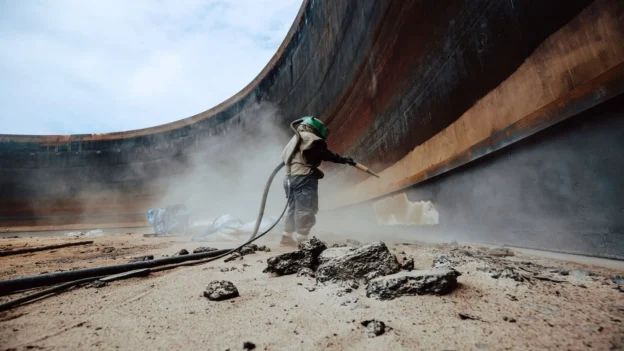Introduction
Metal surface preparation is an important process in various industries, as it ensures proper adhesion and durability of coatings, adhesives, and other applied treatments. This process encompasses a wide variety of advanced techniques, both chemical and mechanical, designed to clean and condition materials such as steel. These techniques are fundamental to remove pre-existing coatings, residues, imperfections, organic matter, oxidation and other contaminants, preparing the surface to apply new treatments in an efficient and durable manner.
This article provides guidance on metal surface preparation methods, highlighting their importance in increasing the efficiency and service life of coatings. It also discusses methods of evaluating and characterizing surfaces to ensure their suitability for coating, welding, or other treatments.
Main techniques for preparing metal surfaces
The following are the most commonly used surface preparation techniques according to the NACE SSPC Standards (AMPP)1:
Sandblasting: Industrial blasting (NACE 8/SSPC-SP 14)
This technique is applied in accordance with NACE 8/SSPC-SP 14 for industrial abrasive sandblasting, achieving a specific degree of cleanliness on steel surfaces prior to the application of a protective coating.
It is important to note that abrasive blast cleaning to White Metal, Near White, commercial cleaning, and light sandblasting are covered in separate standards. Industrial blast cleaning provides a higher degree of cleanliness than light abrasive blasting (SSPC-SP 7/NACE 4), but is less intensive than commercial cleaning (SSPC-SP 6/NACE 3). It is used when it is desired to remove most coatings, scale, and rust, but the extra effort to completely remove these residues is not justified.
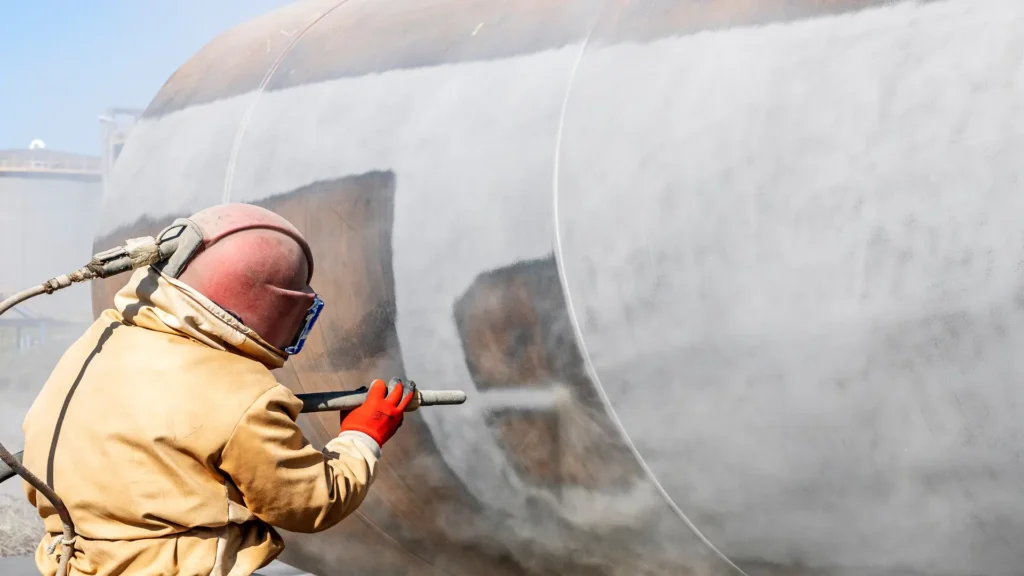
The key difference between industrial blasting and light blasting is that the goal of light blasting is to allow as much of the existing coating as possible to remain in the system, while the goal of industrial blasting is to remove the majority of coatings. Commercial cleaning leaves the surface free of scale, rust, and coatings, allowing staining on less than 33% of the surface. In contrast, industrial blast cleaning allows scale, coating, and rust to remain on less than 10% of the surface and stains are evenly distributed.
Sandblasting, or abrasive sandblasting with sand, can be used to remove paint, varnish, and other impurities from metal surfaces, among others. This technique is an efficient and safe way to remove paint from different materials without damaging them. Sandblasting can also be used to remove rust, residues, and dirt that has remained on a surface for long periods of time.
Shot blasting: Abrasive treatment technique
The term “shot blasting” refers to the process of propelling abrasive material using centrifugal or mechanical force. Unlike sandblasting, shot blasting employs a different pressurization system, using a rotating wheel-like device to accelerate the abrasive material, which is propelled against the surface to be treated.
Shot blasting is a significantly more aggressive abrasive technique than sand blasting, and is generally used on larger, more difficult objects that require a stronger application and a denser abrasive material to clean and prepare the surface. This method requires strict containment, as the force of shot blasting could cause collateral damage if not properly controlled. Shot blasting is commonly found in large-scale industrial operations.
The following video shows the procedure for the application of the shot blasting and painting technique on metal surfaces. Source: Acindec S.A.
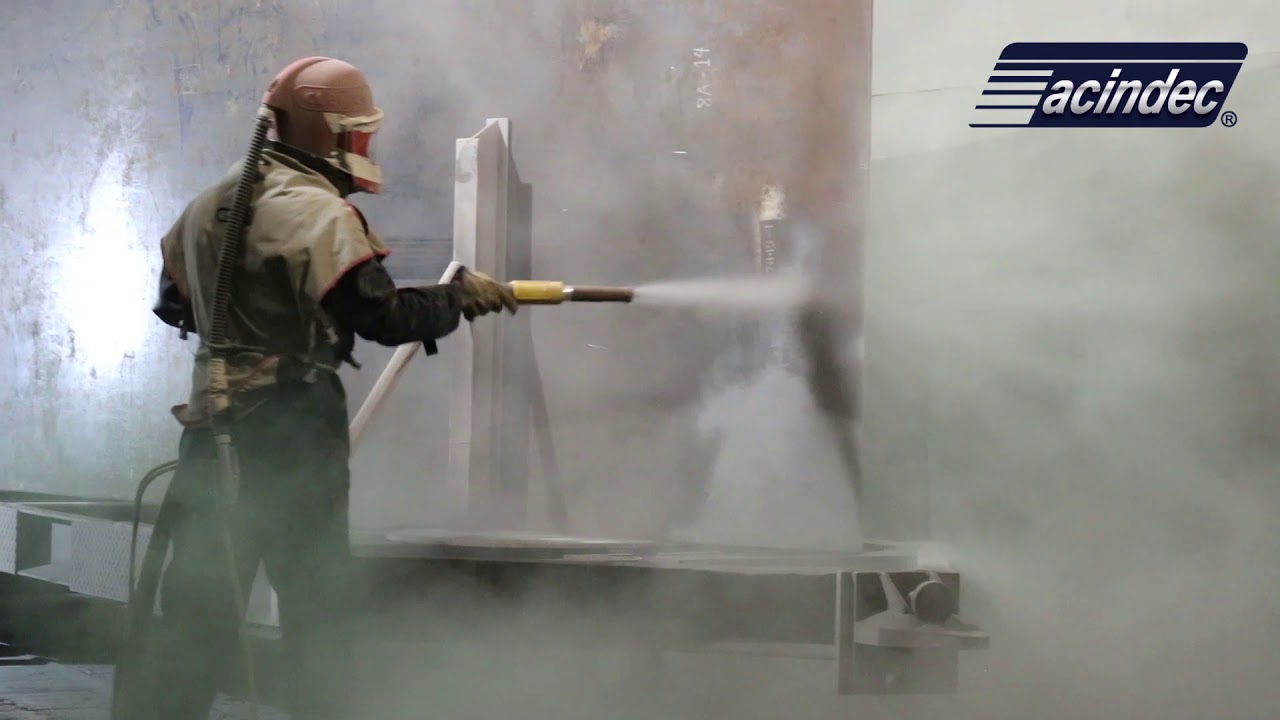
Shot blasting and painting process on metal surfaces.
Cleaning with wet abrasive blasting (Wet Blast)
Dry abrasive blasting is universally recognized as the most efficient and economical technique for cleaning metal structures in industrial applications. Abrasive blasting develops high velocity and surface impact, removing rust, old paint and promoting roughness on the metal base to facilitate excellent adhesion coating2.
However, the use of sand as a dry abrasive has been restricted in recent years due to health concerns (such as silicosis) and environmental impacts. The wet sandblasting process involves the use of abrasive mixed with water, avoiding the creation of dust and reducing the environmental problems associated with dry sandblasting. However, one of the biggest challenges of wet blasting is flash rust, which is minimized by using corrosion inhibitors.
Water jet cleaning (NACE 5 / SSPC-SP12)
The NACE 5 / SSPC-SP12 standard establishes procedures for cleaning metal surfaces with high-pressure water jetting prior to applying coatings or paint. This method reuses the anchor profile already present on the metal surface, rather than creating a new one.
The standard defines four types of water cleaning, based on the outlet pressure:
- Low Pressure Water Cleaning (LP WC): Less than 34 MPa (less than 5,000 psi).
- High Pressure Water Cleaning (HP WC): Between 34 MPa and 70 MPa (5,000 to 10,000 psi).
- High Pressure Water Jetting (HP WJ): Between 70 MPa and 170 MPa (10,000 to 30,000 psi).
- Ultra High Pressure Water Jetting (UHP WJ): More than 170 MPa (more than 30,000 psi).
Equipment for this type of cleaning can be manual or automatic (robotic) and requires a water source, a pump to pressurize, hoses, nozzles, and control valves.
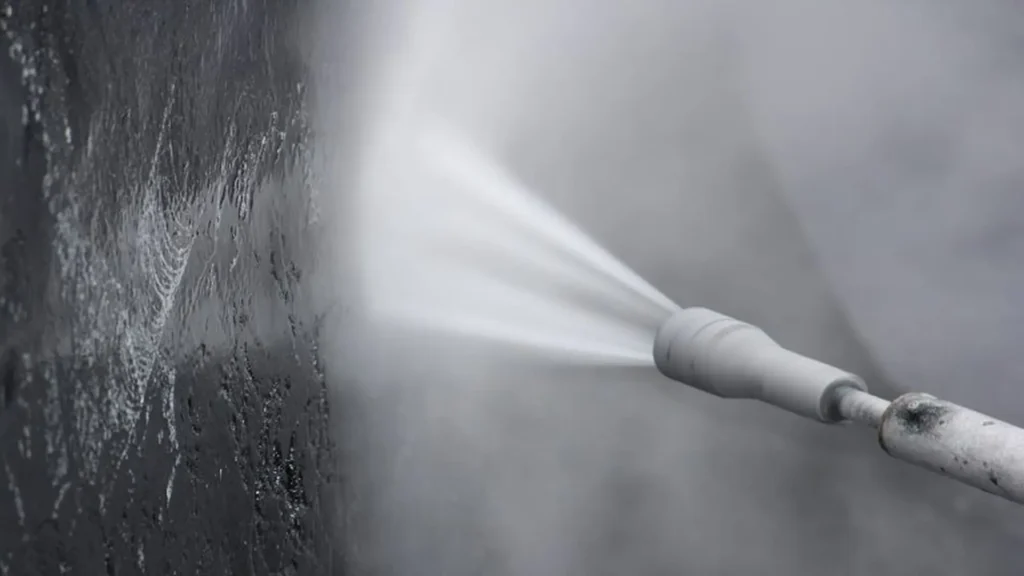
Chemical cleaning (SSPC-SP8)
Chemical cleaning is a method of metal surface preparation that removes rust by chemical reaction, electrolysis or a combination of both methods. This process ensures that the metal surface is completely free of rust scale and other contaminants. In addition, the surface must be free of inactive acid or alkali residues.
After chemical cleaning, the surface must be completely dry before any coating is applied to avoid adhesion and corrosion problems. If chemical treatment is specified, it should be performed before any visible signs of corrosion appear. This method is especially useful in situations where other cleaning methods (manual, mechanical, abrasive) are not feasible due to physical constraints.
Due to the aggressive nature of the chemicals used, it is essential to handle these materials with great care, as they can cause damage to the skin, eyes, and respiratory tract. The use of safety elements such as goggles and gloves is indispensable to protect the operator during the chemical cleaning process.
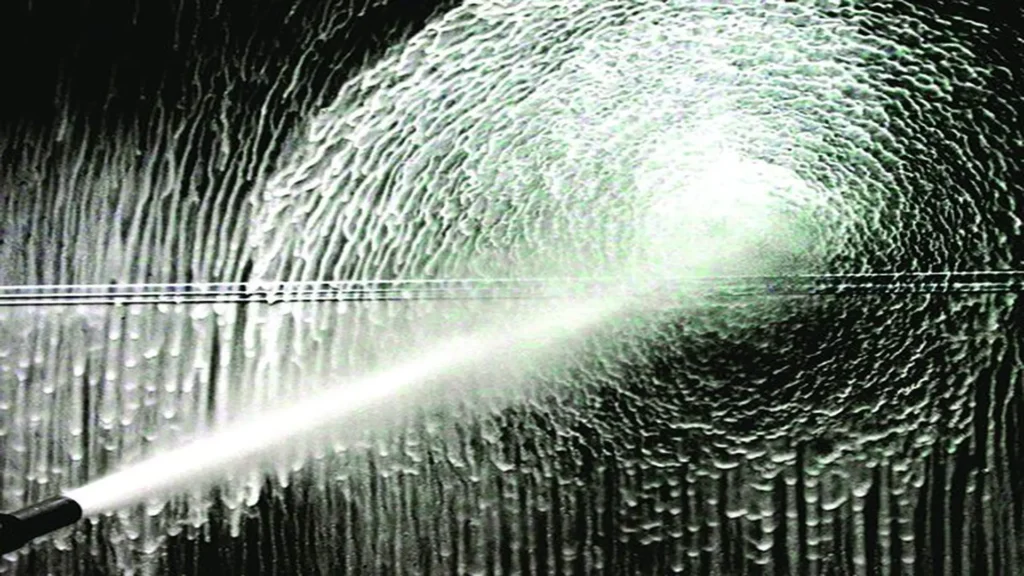
What are the techniques for the evaluation of metallic surfaces?
There are several techniques and methods that can be used to evaluate the topography and roughness of metal surfaces. These methods are crucial to ensure proper preparation and to determine the suitability of the surface for subsequent processes such as coating, welding, or other treatments3.
Below are some common techniques used to evaluate the topography and roughness of a metal surface:
Profilometry techniques
Mechanical profilometry is a technique for measuring the topographic profile of a surface by contact. A special very fine diamond tip is used to sweep that area accurately while recording its vertical movement with nano-metric resolution.
Profilometry techniques provide quantitative measurements of various surface roughness parameters, such as average roughness (Ra), root mean square roughness (Rq) and maximum peak-to-valley height (Rt or Rz). These parameters are essential to determine the suitability of the surface for specific applications and to ensure compliance with industry standards.
Microscopy techniques
These techniques, including optical microscopy, scanning electron microscopy (SEM), and atomic force microscopy (AFM), can be used to visually examine and characterize the topography and roughness of metal surfaces at high magnification.
Replication techniques
Replication techniques involve the creation of a replica or mold using materials such as silicone rubbers or epoxy resins. These replicas can then be examined using various microscopy or profilometry techniques to analyze the surface indirectly.
Comparison methods
Comparison methods involve comparing the roughness of the metal sample with standardized roughness samples or reference surfaces. These reference areas have known and calibrated roughness values, allowing a comparative evaluation of the metal.
The choice of technique depends on factors such as the required level of accuracy, the size, accessibility, and material of the surface, and the specific application or industry standards.
Innovations and emerging technologies
Laser technology has emerged as an advanced and efficient solution for cleaning metal surfaces, using high-precision laser pulses to remove various contaminants such as rust, grease, oil, soot, and other impurities.
The laser cleaning process involves the use of high-intensity laser light pulses that irradiate the metal surfaces. The laser energy is absorbed by the impurities, resulting in their evaporation or sublimation, leaving the underlying metal clean and undamaged. The main capabilities of laser technology include:
- High precision: The ability to focus the laser with high accuracy allows selective cleaning of specific areas without affecting the base material.
- Effective contaminant removal: The laser can effectively remove rust, grease, grease, oil, soot, and other unwanted particles.
- Adaptability: It is applicable to various types of metals and a variety of component sizes and shapes.
Laser technology has established itself as an advanced and effective tool for cleaning, offering numerous advantages over traditional methods. Its ability to remove a variety of contaminants with high precision, without damaging the base material and without generating hazardous waste, makes it ideal for a wide range of industrial applications.
Conclusions
There is no single perfect method for preparing metal surfaces; the choice must be based on substrate type, project requirements and environmental conditions. Mastering these techniques and evaluating them can maximize coating life, improve corrosion protection and reduce premature failure costs. In demanding industries such as aerospace, automotive and electronics, surface preparation not only ensures strong adhesion, but directly impacts the safety and ultimate performance of products and components.
References
- https://blogs.ampp.org/protectperform/surface-prep-standards-a-quick-summary
- https://nanografi.com/blog/anticorrosive-nanocoatings
- https://www.researchgate.net/publication/372532299_Surface_Engineering_of_Metals_Techniques_Characterizations_and_Applications

